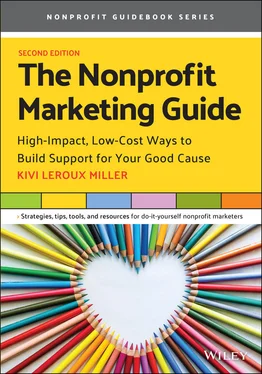THE OFFICIAL DEFINITION OF MARKETING
Consider this official definition of marketing from the American Marketing Association: “Marketing is the activity, set of institutions, and processes for creating, communicating, delivering, and exchanging offerings that have value for customers, clients, partners, and society at large.”
As you can see, it's much more than just communicating about the programs or services that your nonprofit provides. Marketing is also about creating those programs or services, from the outset, and delivering them to your participants and supporters. Thus, marketing is not just something you do when you have the time or money; it's an essential component of a well-run organization, right alongside strategic planning, financial management, and evaluation of your effectiveness in implementing your mission.
Also included in the formal definition of marketing is exchanging offerings that have value – in simpler terms, you give a valuable to someone and you get one from them in return. In the business world, a person gives money to a business and the business gives them a service or product, like a box of cereal. But long before you walk out of the grocery store with a box of Crunchy Cocoa Flakes, the business's marketing department has helped determine how that cereal tastes and what it looks like in the bowl, because they have learned all about the cereal preferences of people that make up families like yours. They've figured out how much to charge you for it, based not on production costs alone but also on what they think you'd be willing to pay. They've also decided which stores will carry the cereal on their shelves. They've figured out what the box should look like and what they need to put in the TV commercials, so your kids won't stop bugging you until you add Crunchy Cocoa Flakes to the shopping list.
Of course, it's not quite that simple in the nonprofit world.
Instead of boxes of cereal, nonprofits are often “selling” products and services that are much more abstract, such as education, advocacy, facilitation, technical assistance, and networking. Many times, the characteristics and descriptions of those products and services are not solely for the nonprofit to decide; they are defined instead by government agencies, foundations, and other institutions that fund or regulate the nonprofit's programs.
The exchange is also not as simple as swiping a debit card and walking out of a store with a bag full of groceries. In the nonprofit world, programs are often offered to individuals for free, because their creation is paid for by contracts, grants, or charitable donations. The individual participants pay for what's offered with something other than money, such as their time, by performing a desired action, or simply by demonstrating a willingness to consider a different point of view.
In addition to these costs to both the nonprofit and the participants, we must also consider what's called the “benefit exchange.” What does the nonprofit get out of it, and what does the participant get out of it? Where is the real value to both parties? Nonprofits often get one step closer to achieving their mission, whether it's reducing domestic violence or beautifying a neighborhood. Participants, on the other hand, often get some kind of emotional payback, such as feeling physically safer or knowing they've made their community a better place for their children.
The same is true for people who support nonprofits with donations of time, talent, and money. Nonprofits receive these benefits and in exchange, supporters get something too. Sometimes it's concrete, like tickets to an event or a fancy meal. Other times, it's an emotional benefit, such as feeling proud or inspired. Supporting a nonprofit can also affirm one's identity as a good person or as someone who makes a difference in the lives of others.
IS THIS WORK CALLED MARKETING OR COMMUNICATIONS OR SOMETHING ELSE?
I participate in numerous social media groups for nonprofit communicators, and several times a year, someone wants to debate the difference between marketing and communications . Sometimes words like public relations or outreach are also thrown in the mix. Many of these debates center on which words should be included in someone's job title or team name. As organizations grow, we also sometimes see battles about which executives or staff teams will control the various aspects of marketing and communications work, which also leads to parsing the definitions as the work is divided.
The practical reality is that both words, marketing and communications , are used interchangeably in the nonprofit sector. Communications director, manager, or coordinator is a much more common job title than marketing director, manager, or coordinator. However, those communications directors are almost always doing what I consider both marketing and communications work.
When asked to define the differences between marketing and communications , I tend to simplify the conversation by saying that marketing is the more strategic form of this work, and communications is the more tactical form.
Marketing is about the value exchange. You have to know who you are talking to, what messages will resonate with them, and the best ways to deliver those messages. Those are strategic choices. Communications, on the other hand, is all of the content you create and your plan to distribute that content so that you can maintain relationships with the people consuming that content. Every nonprofit needs both.
Again, in practice, both words are used interchangeably in the nonprofit sector. If you are speaking with someone who insists the terms are different, I encourage you to explore their definitions in the context of your conversation, so you fully understand the implications of those word choices.
A MORE MEANINGFUL DISTINCTION: MARKETING FOR FUNDRAISING OR FOR COMMUNITY ENGAGEMENT
After coaching hundreds of nonprofit communications directors, I've found that rather than debating whether they are doing marketing or communications, it's more meaningful to discuss whether they are marketing for the primary purpose of fundraising or marketing for the much broader purpose of community engagement.
Through the many years of research for Nonprofit Marketing Guide's annual Nonprofit Communications Trends Reports , we found a pattern: communications directors answered our survey questions quite differently depending on the “why” behind their work. We found a nearly equal split: about half of nonprofit communicators work directly in support of fundraising goals and the other half work more broadly for community engagement, which may or may not include some fundraising.
Communications staff who work primarily in service of fundraising goals have a more well-defined target audience: donors. Much of the communications they produce fit within the “Ask, Thank, Report” donor communications cycle. They ask for donations, then thank donors for their support – both individually and collectively – and then report back on the good works that those donors have made possible, often using a supporter-centered style of writing. (We'll explore ways to express gratitude in particular in Chapter 9and various nonprofit writing styles in Chapter 10.) These communicators often focus more on direct mail and events as communications channels, as compared with staff who are not personally responsible for fundraising goals.
The other half of nonprofit communicators focus more broadly on community engagement, with fundraising as a secondary or tertiary goal, if at all. Their primary goals, target audiences, messages, and communications channels are usually much more varied than those of communicators focused more narrowly on fundraising.
Читать дальше












